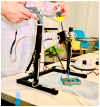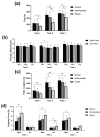LAPKaans: Tool-Motion Tracking and Gripping Force-Sensing Modular Smart Laparoscopic Training System
- PMID: 33291631
- PMCID: PMC7730101
- DOI: 10.3390/s20236937
LAPKaans: Tool-Motion Tracking and Gripping Force-Sensing Modular Smart Laparoscopic Training System
Abstract
Laparoscopic surgery demands highly skilled surgeons. Traditionally, a surgeon's knowledge is acquired by operating under a mentor-trainee method. In recent years, laparoscopic simulators have gained ground as tools in skill acquisition. Despite the wide range of laparoscopic simulators available, few provide objective feedback to the trainee. Those systems with quantitative feedback tend to be high-end solutions with limited availability due to cost. A modular smart trainer was developed, combining tool-tracking and force-using employing commercially available sensors. Additionally, a force training system based on polydimethylsiloxane (PDMS) phantoms for sample stiffness differentiation is presented. This prototype was tested with 39 subjects, between novices (13), intermediates (13), and experts (13), evaluating execution differences among groups in training exercises. The estimated cost is USD $200 (components only), not including laparoscopic instruments. The motion system was tested for noise reduction and position validation with a mean error of 0.94 mm. Grasping force approximation showed a correlation of 0.9975. Furthermore, differences in phantoms stiffness effectively reflected user manipulation. Subject groups showed significant differences in execution time, accumulated distance, and mean and maximum applied grasping force. Accurate information was obtained regarding motion and force. The developed force-sensing tool can easily be transferred to a clinical setting. Further work will consist on a validation of the simulator on a wider range of tasks and a larger sample of volunteers.
Keywords: additive manufacturing; force sensor; laparoscopic surgery; motion tracking; surgery simulator.
Conflict of interest statement
All authors declare no competing financial interest.
Figures











References
-
- Markets R. Global Laparoscopy and Endoscopy Devices Market, 2025—Focus on Surgical Procedures (Cholecystectomy and Hysterectomy) and Product Types (Arthroscopes, Neuroendoscopes, Cystoscope, and Bronchoscopes) [(accessed on 7 October 2020)]; Available online: http://www.globenewswire.com/news-release/2018/09/19/1572863/0/en/Global....
-
- Operative Laparoscopy: Overview, Periprocedural Care, Technique. [(accessed on 25 May 2020)]; Available online: https://emedicine.medscape.com/article/1848486-overview.
MeSH terms
LinkOut - more resources
Full Text Sources

